Books
Books

The Error is Regretted
‘Corrections and Clarifications’ is an ongoing newsprint project by Anita Di Bianco, an edited compilation of daily revisions, retractions, re-wordings, distinctions, and apologies to print news from September 2001 to the present. In essence, a reverse chronological catalogue of lapses in naming and classification, tangled catchphrases, and patterns of misspeak and inflection.
Previous editions have examined the printed news media in the United States and United Kingdom, Germany, Austria and Switzerland, and other international press from Asia, Turkey, and the Balkans printed in English. The publication includes text contributions by Di Bianco and Francesco Gagliardi.
108 p, ills bw, 24 x 32 cm, hb, German/English

Loving Characters Into Gas Station Snacks
Katinka van Gorkum, Sára Iványi
In the early winter of 2019, Katinka van Gorkum and Sára Iványi met online after creating personal ads on a text-based dating app called Lex. Without knowing who the other person was or what they looked like, they started writing to each other on a daily basis. This exchange is presented here as a kind of un-edited textual performance in which the act of language functions under the most intense pressure—how can we perform our ‘selves’ only through the use of words? How do the negotiations of the early stages of friendship, romance, sexuality, hold up under these conditions? How does language itself?
Katinka van Gorkum was raised in Barendrecht, a suburb of Rotterdam where people remove the leaves from their gardens with a vacuum cleaner. As an artist and writer, she investigates the interior world of humans through the private domain.
Sára Iványi was born in Budapest when there was still an iron curtain and moved to Amsterdam at a young age. This experience has led her to question the notion of boundaries in every sense and drew her to the idea of language being an alien or parasitic life form.
34 p, ills colour & bw, 15 x 21 cm, pb, English
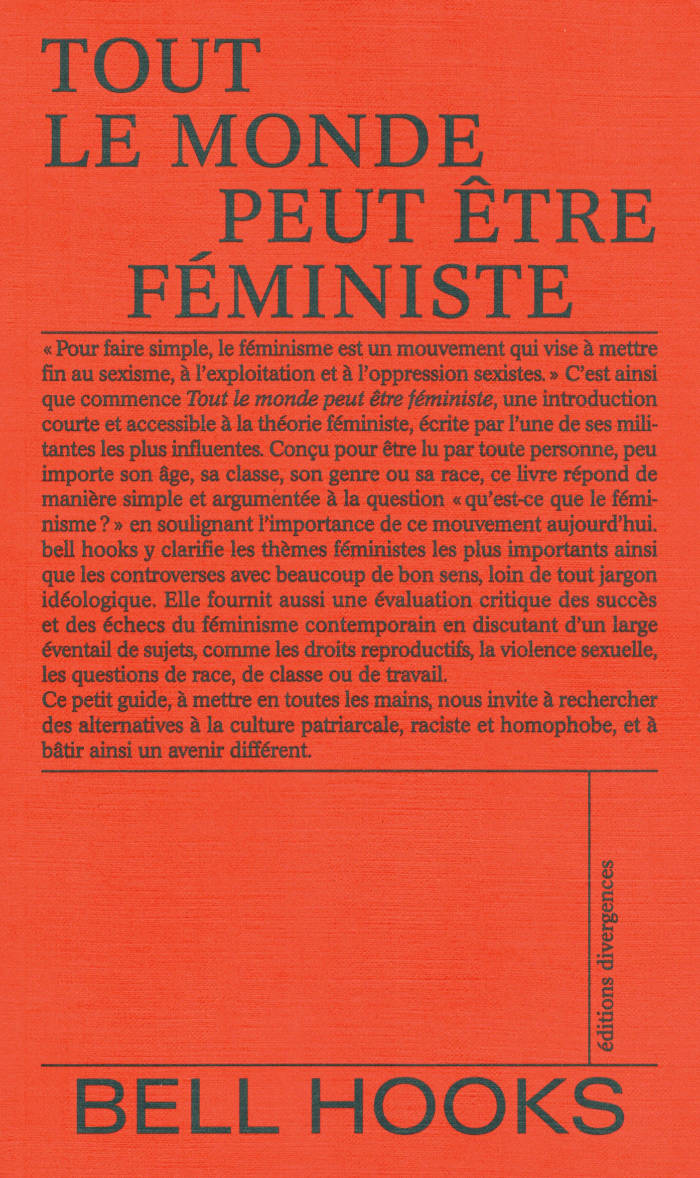
Tout Le Monde Peut Être Féministe
« Pour faire simple, le féminisme est un mouvement qui vise à mettre fin au sexisme, à l’exploitation et à l’oppression sexistes. » Ainsi débute cette efficace et accessible introduction à la théorie féministe, écrite par l’une de ses figures les plus influentes, la militante noire-américaine bell hooks.
Conçu pour pouvoir être lu par tout le monde, ce livre répond de manière simple et argumentée à la question « qu’est-ce que le féminisme ? », en soulignant l’importance du mouvement féministe aujourd’hui. Ce petit guide, à mettre entre toutes les mains, nous invite à rechercher des alternatives à la culture patriarcale, raciste et homophobe, et à bâtir ainsi un avenir différent.
Traduit de l'anglais par Alex Taillard

Forlaget Emancipa(t/ss)ionsfrugten
Great is the Power of the Name
Signe Frederiksen, Anne-Mette Schultz
Great is the Power of the Name considers the works of authors Elena Ferrante, Pauline Reáge, Karl Ove Knausgård, Colette and artist Lee Lozano.
In 2016, when Anne-Mette had invited Signe to take on the role as editor of her text The Institute of Applied Speech, they both began reading Elena Ferrante's The Neapolitan Novels. They were specifically fascinated by the author’s use of pseudonym. Anne-Mette's Institute of Applied Speech was a tale of a fictive place, a pseudo-topos, and Elena Ferrante’s ideas about the pseudonym as a space for the writing itself was useful in thinking about fictive authorship. In a number of written interviews, Elena Ferrante unfolds the feminist perspective of her use of pseudonym. They were attracted by the idea that the author could avoid the biographical question; that she could disappear behind her own writing.
To them, the artist Lee Lozano is the ghostly presence of hard-core moralist and humorous fuck-off art from another decade. During the course of her life, Lozano continuously reconfigured and gradually dissolved her own name, starting from Leonore Knaster ending up with E. Her work Boycott Women, in which she decides not to have any contact with women, expands the notion of feminist critique.
Great is the Power of the Name publishes a readership interested in the position of the artist, and how it conditions the way we make art.

17 Movements
17 Mouvements collects traces of a project that Decoratelier - the workspace and arts platform of Jozef Wouters - did in the fall of 2022 around the ‘5 blocs’ area in Brussels (Rempart Des Moines/Papenvest).
When Nuit Blanche invited them to build a gym, Camille Thiry and other Decoratelier associates did not want to design another generic muscle cage. Together with the neighbourhoods inhabitants, they built 17 distinct movement spaces, each tailor-made to an individual’s size, needs, dreams and aches. The gym equipment has meanwhile been removed from public space, but this eponymous book (ed. by Jozef Wouters) combines notes and reflections (language: French) by Camille with beautiful photography by Enzo Smits, documenting the ingenious and unique negotiations that were a part of this collaboration.

The Waterfront Journals (US edition)
David Wojnarowicz came to fame in the 1980s as a radical artist whose work challenged the boundaries of art, making him, for a time, the object of Jesse Helms's conservative backlash. Before his death in 1992, he was established as an outspoken AIDS activist, anticensorship advocate, and groundbreaking artist and writer. New York called him a "spokesman for the unspeakable," and The New York Times declared that "his most lasting legacy will be as a writer."
The Waterfront Journals is a collection of his early works of autobiographical fiction. Written as short monologues, each is in the voice of one of the many people he encountered in his travels throughout America in the late 1970s and early 1980s, when he was living on the street.
Wojnarowicz stumbles upon his characters in bus stations, at the side of the road, in hotels, coffee shops, and back alleys, where their interactions are less than epic, but unnervingly intimate. The Waterfront Journals is a testament to their identities, and of Wojnarowicz's grace as a writer.

Gaia And Philosophy
In the 1970s, microbiologist Lynn Margulis and atmospheric chemist James Lovelock developed the Gaia theory. Embracing the circular logic of life and engineering systems, the Gaia theory states that Earth is a self-regulating complex system in which life interacts with and eventually becomes its own environment.
Gaia describes a living Earth: a body in the form of a planet. For billions of years, life has created an environment conducive to its continuation, influencing the physical attributes of Earth on a planetary scale. An idea with precedents in natural science and philosophy for millennia, Gaia resonates with the ancient magico-religious understanding that all is one: as above, so below.
Fusing science, mathematics, philosophy, ecology and mythology, Gaia and Philosophy, with a new introduction by Dorion Sagan, challenges Western anthropocentrism to propose a symbiotic planet. In its striking philosophical conclusion, the revolutionary Gaia paradigm holds important implications not only for understanding life's past but for shaping its future.
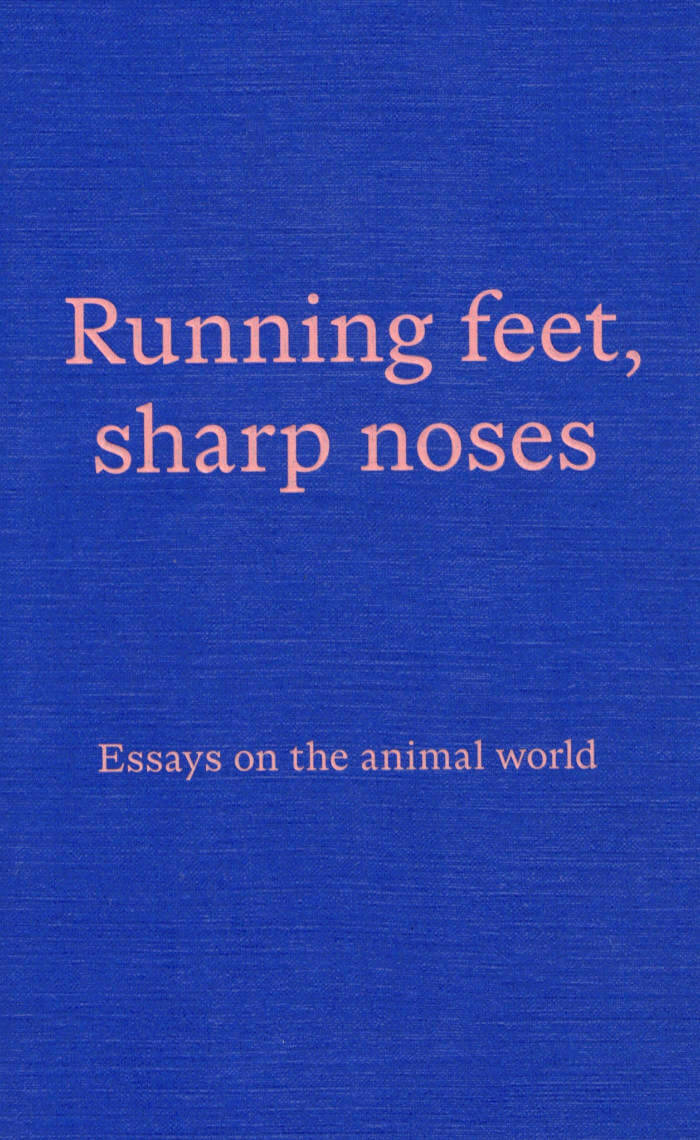
Running feet, sharp noses
and Niamh Dunphy, Adrian Duncan and 1 more
Edited by Nathan O’Donnell, Adrian Duncan, and Niamh Dunphy, Running feet, sharp noses: Essays on the animal world is a collection of essays on the animal world. Each piece is a meditation on how animals affect our sense of self, our memories, our actions.
With contributions by Latifa Akay, Sara Baume, John Berger, June Caldwell, Niamh Campbell, Vona Groarke, Edward Hoagland, Sabrina Mandanici, Darragh McCausland, Tim MacGabhann, Honor Moore, Eileen Myles, Stephen Sexton, Jessica Traynor, Erica Van Horn, and Suzanne Walsh.

Solitary Pleasure: Selected Poems, Journals and Ephemera
Solitary Pleasure is a new collection of poetry, journal entries, letters and ephemera by the American poet John Wieners, edited by Richard Porter with an introduction by Nat Raha.
John Wieners (1934-2002) was a poet, a Black Mountain College alumnus and an antiwar, gay rights & mental health activist.
‘John Wieners has been described as both ‘the greatest poet of emotion’ (by Robert Creeley) and ‘the poet laureate of gay liberation’ (within the Gay Liberation press). Solitary Pleasure delivers us this poet raw with mid-century queer feelings. Here, we encounter a writer preoccupied with the power and magic of poetics to profoundly render love, loss and survival in the face of destruction.’
— Nat Raha, from the introduction
'Solitary Pleasure is a selected collection of Wieners’ poems, appended with letters and journal entries. An introduction, written by contemporary poet Nat Raha, makes a powerful case for reading Wieners’ work as art born from “the heart of struggle”. The poems themselves are offhand and diaristic. Sometimes, they deploy childlike rhymes that purposely steer close to nonsense, successfully generating a sense of wonder (“If I had a canoe / I’d fill it with you / Then what would you do”). The Wieners of Solitary Pleasure is a poet eager to vocalise queer desire. “The beauty of men never disappears,” he writes, later portraying desire as something that must be “choked” out of him. Occupying nearly a third of Solitary Pleasure are his “Asylum Poems”, which Wieners wrote in 1969 – the summer of the Stonewall riots – while in a psychiatric institution. These poems spotlight the connection between art and affliction, but challenge us to consider creative expression as a very real mode of survival and salvation, and not merely, as current wellness discourses suggest, a potential curative or preventive to mental ill-health.'
— Ralf Webb for The Guardian

Responses to Untitled (eye with comet) By Paul Thek
Responses to Untitled (eye with comet) (c.1985) by Paul Thek is the sixth and final anthology in a series that gathered responses to works of art made during a period of the ongoing AIDS Crisis, from the identification of the virus in 1981 to the introduction of life-saving drugs in 1996.
In this sixth iteration, responses were sought to the painting Untitled (eye with comet) by Paul Thek. The work was found in his storage after his death from AIDS in 1988.
List of contributors in order of appearance:
E.R. De Siqueira
Ben Estes
João Motta Guedes
Lucy Swan
Jon Rainford
Louis Shankar
Amy Evans Bauer
Hattie Morrison
Sammy Paloma
AN Grace
James Horton
Nick Wood
Sophie Paul
Jae Vail
Elizabeth Zvonar
Lars Meijer
Clay AD
Michel Kessler
Pablo Miguel Martínez
Emma Harris
Dylan McNulty-Holmes
Kitya Mark
Katherine Franco
Ainslie Templeton
Alistair McCartney
John Brooks
Jesse Howarth
jimmy cooper
Felix Pilgrim
Nicholas Chittenden Morgan
Murphy O’Neir
Rachel Cattle
Isabel Nolan
Susan Finlay
Ted Simonds
Brooke Palmieri
Kate Morgan
Ashleigh A. Allen
Diogo Gama
JP Seabright
Hugo Hagger
Amanda Kraley
Brendan Cook
Matt Bailey
Charlotte Flint
Rodney Schreiner
Lucy Price
Morgan Melhuish
Jordan Weitzman
Jaakko Pallasvuo
Alex Fiorentino
Harald Smart
Marguerite Carson
loll jung
Richard Porter
Nicholas Kalinoski
Hedi El Kholti
Edmund Francis English
Ted Bonin

A Book of Music (1958)
A new edition of the posthumously published collection 'A Book of Music' by the American poet Jack Spicer (1925-1965).
While little known outside a circle of friends and poets in his lifetime, Spicer is widely considered one of the major figures of twentieth century American poetry.
After being removed from a teaching position at Berkeley in 1950 for refusing to pledge allegiance to the United States, he became a founder of the radical and counter-cultural San Francisco Renaissance movement of poets in an age when homosexuality was illegal.
He believed that the poet was a “radio” able to collect transmissions from an “invisible world,” as opposed to the idea that poetry was driven by a poet’s voice and will. In this sense he believed that his poems were dictated from a spirit world and saw poetry as a form of magic, most potent when spoken aloud.
He died at the age of 40 in the poverty ward of San Francisco General Hospital, from acute alcohol poisoning. One of his last coherent sentences was, “My vocabulary did this to me.”
This new edition of A Book of Music, published 65 years after its original was composed, is risograph printed on Munken Lynx paper and saddle-stitched by Earthbound Press.
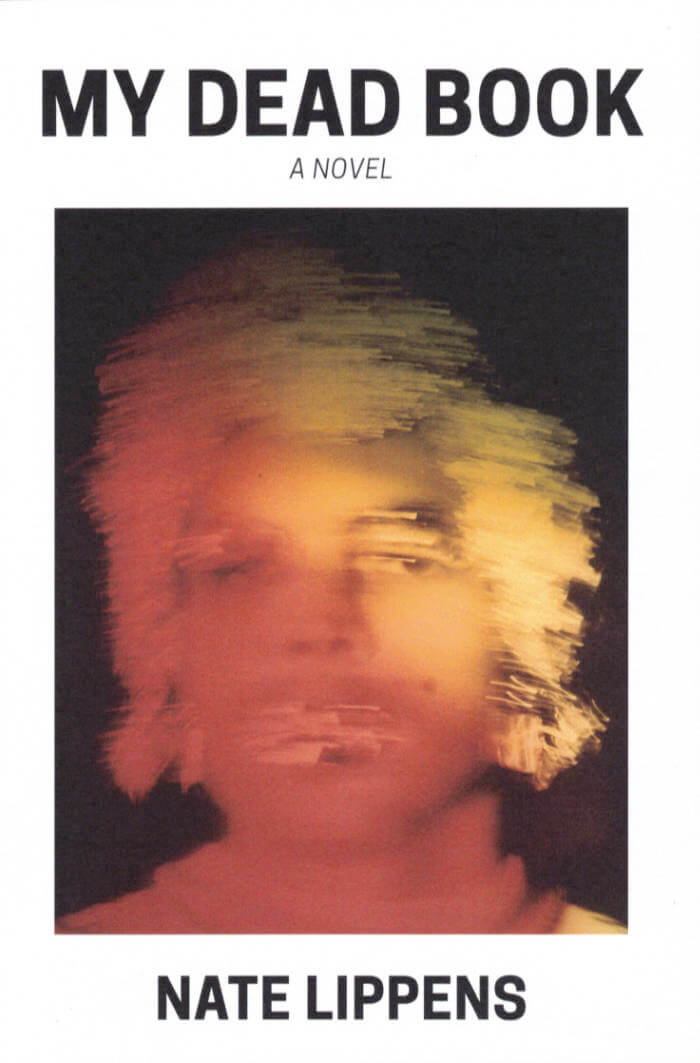
My Dead Book: A Novel
My Dead Book is a novel composed of nonlinear vignettes and fragments about a queer man approaching his fiftieth birthday who is haunted by insomnia and his past. In the dead of night, he remembers his friends who died in the late 1980s and 1990s, his years as a teenage throwaway and sex worker, and ruminates on working class survival, queer aging, AIDS, and whether he has outlived his place in the world.
“What a blistering book—with My Dead Book, Nate Lippens has created something truly fucking great. It's as if the storied stars of Lou Reed's 'Walk on the Wild Side' overshot Manhattan and wound up in Wisconsin, broke and blue with cold and depressed beyond belief by the thought that this nowhere is now home. It's a bitter pill, but I love bitterness, and who doesn't love pills?”— Derek McCormack, author of Castle Faggot
“There’s no doubt to this book. You’d think that was a flaw but it’s been burned away. My Dead Book is not short though it is brief. It’s loving, bittersweet, and actually courageous because it tells a story that is slightly unbearable because it’s all secret, awful hard bad secrets and funny as hell. Nate’s balancing act works because the heart of it (this novel) is true even though it’s often heartless. It’s simple. He knows what things are worth. When you need the sea or a bird they’re there like they never were before.”
— Eileen Myles, author of Afterglow
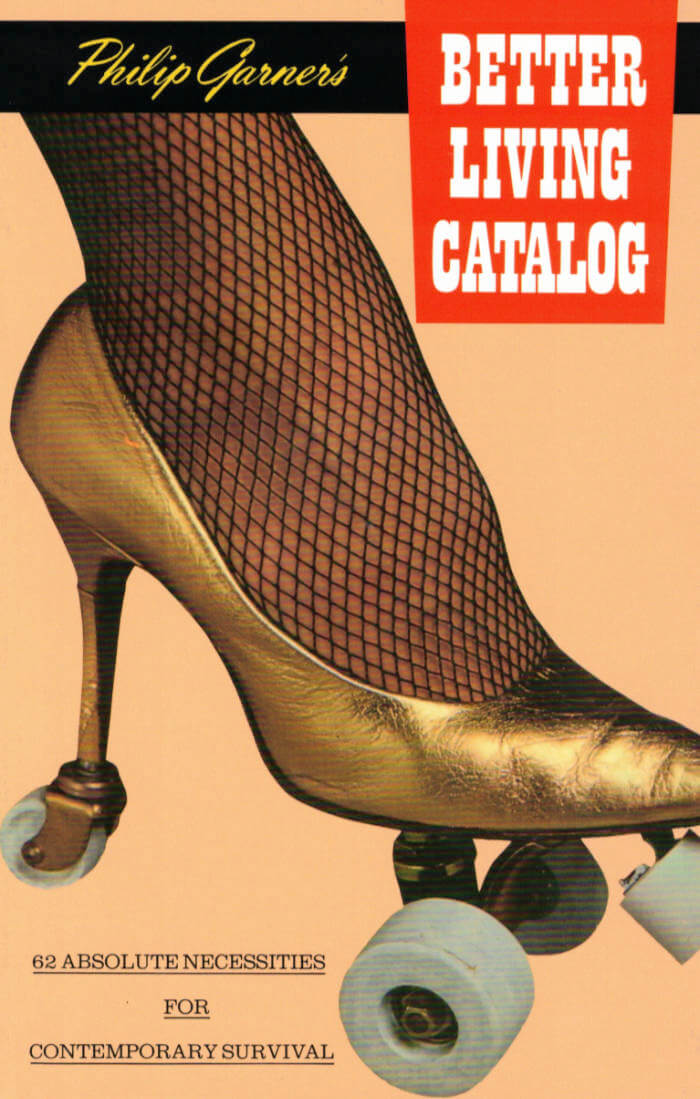
Better Living Catalog
Pippa Garner’s Better Living Catalog, originally published in 1982, takes the form of a mail order catalog featuring clever and whimsical inventions that parody consumer goods while simultaneously critiquing America’s obsession with ingenuity, efficiency, leisure, and comfort. These works, which were made as prototypes and photographed for the publication, take the form of improbable accessories, clothing, footwear, home appliances, and office gadgets.
For example, the “Reactiononometer,” a portable wristband, instantly measures social success, while the “Digital Diet Loafers” display the wearer’s weight with every step. If the “Munch-o-Matic” reduces deskwork interruptions by flinging a snack right into the user’s mouth, other items promise financial solvency (the controlled cash flow “Autowallet”), sustainable waste management, or mess-free companionship (the “Pet-a-Vision” TV console). The artist asserts that all of the products in the book are “absolute necessities for contemporary survival.”
The Better Living Catalog was a pop hit when it was published, earning Garner spots on nighttime TV talk shows and attention from magazines like Vogue and Rolling Stone. In a meme-filled culture, the works still resonate today, finding their analog in widely-circulating consumer products, and—in the case of the “High Heel Skates”—even appearing unattributed in the runway collection of a major luxury fashion brand.
A few years after the Better Living Catalog was published, Garner began her gender transition, which she has characterized as an artistic project that draws conceptual parallels to the altered consumer goods she has continued to create since the 1970s. The artist’s practice has always been about hacking—gender hacking, she stated, was “an excellent premise for maverick conceptual art and diametrically opposed to anything I’d ever done.”
Many of the prototypes Garner created for the publication were repurposed or recycled, making this previously rare gem of an artist book one of the artist’s few works to now be widely available.
Born in 1942 in Evanston, Illinois, Pippa Garner (formerly known as Philip Garner) began her practice in the late sixties as a member of the highly regarded Transportation Design department at ArtCenter, California, with plans to become a car stylist, and was drafted to Vietnam to serve as a combat illustrator. In the mid-80s, Garner began her gender transition, which she considers a conceptual artwork, marking an extension of her practice from twenty years of altering cars, garments, and consumer products to using her own body as raw material. Garner appeared on the Tonight Show Starring Johnny Carson and other talk shows, showcasing her satirical consumer product inventions, and her artwork has been featured in Car & Driver, Rolling Stone, Arts & Architecture, and Vogue, among other publications. In the 1980s, her performance, design, and video work was exhibited in institutions including the Los Angeles Institute of Contemporary Art; Whitney Museum of American Art; and Museum of Contemporary Art, Los Angeles; since 2015, she has had exhibitions at STARS, O-Town House, Redling Fine Art, and Parker gallery in Los Angeles; Jeffrey Stark in New York; JOAN, Los Angeles; Kunstverein München; 49 Nord 6 Est – Frac Lorraine, Metz; Kunsthalle Zurich; and Art Omi, Ghent, New York. She is the author of three other books: Utopia… or Bust! Products for the Perfect World (1984), Garner’s Gizmos & Gadgets (1987), and the zine Beauty 2000 (1992/2021).

The Poetics of Wrongness
In her first book of critical non-fiction, The Poetics of Wrongness, poet Rachel Zucker explores wrongness as a foundational orientation of opposition and provocation.
Devastating in their revelations, yet hopeful in their commitment to perseverance, these lecture-essays of protest and reckoning resist the notion of being wrong as a stopping point on the road to being right, and insist on wrongness as an analytical lens and way of reading, writing, and living that might create openness, connection, humility, and engagement.
This book marks a turning point in Zucker's significant body of work, documenting her embrace of the multivocality of interview in her podcasting, and resisting the univocality of the lecture as a form of wrongness in and of itself.

Diego Garcia (Semiotext(e) / Native Agents)
Natasha Soobramanien, Luke Williams
Edinburgh, 2014. Two writer friends, Damaris and Oliver Pablo, escape London, the city that killed his brother. They spend their days trying to get to the library, bickering over their tanking bitcoin, failing to write or resist the sadness. Then they meet Diego, a poet. He tells them he is named for his mother’s island in the Chagos Archipelago, which she and her community were forced to leave by British soldiers in 1973. Damaris and Oliver Pablo become obsessed with this notorious episode and the continuing resistance of the Chagossian people, and want to write in solidarity. But how to share a story that is not theirs to tell? And how to account for a loss not theirs to grieve? A tragicomedy interrogating the powers of literature alongside the crimes of the British government, Diego Garcia is a collaborative fiction that opens up possibilities for the novel and seeks other ways of living together.
Natasha Soobramanien and Luke Williams are the authors of Genie and Paul and The Echo Chamber, respectively. They used to live in Edinburgh but now live in Brussels, across the park from one another, where they meet up every day for a walk.

On the Inconvenience of Other People
In On the Inconvenience of Other People Lauren Berlant continues to explore our affective engagement with the world. Berlant focuses on the encounter with and the desire for the bother of other people and objects, showing that to be driven toward attachment is to desire to be inconvenienced. Drawing on a range of sources, including Last Tango in Paris, Ralph Waldo Emerson, Claudia Rankine, Christopher Isherwood, Bhanu Kapil, the Occupy movement, and resistance to anti-Black state violence, Berlant poses inconvenience as an affective relation and considers how we might loosen our attachments in ways that allow us to build new forms of life. Collecting strategies for breaking apart a world in need of disturbing, the book's experiments in thought and writing cement Berlant's status as one of the most inventive and influential thinkers of our time.
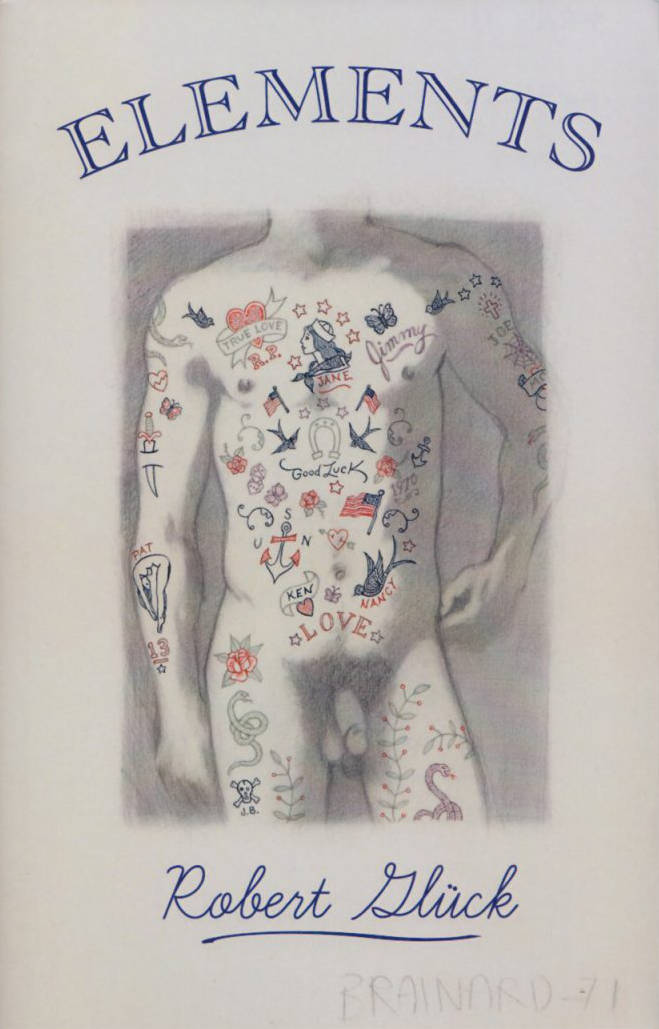
Elements
This collection of stories by Robert Gluck was originally published in 1982 in San Francisco by Four Seasons Foundation under the title ELEMENTS OF A COFFEE SERVICE.
"Bob's fiction is actually quite friendly yet he cuts it with a knife. Bob's gift to the history of letters I think is the uncanniness of his flow. He pulls down the page like a shade, it's masterful what he does. His page is more filled with light than words, really. More filled with temperature too." - Eileen Myles, from the preface to Elements

A Key Into the Language of America
The legacy of cultural imperialism, the consequences of gender, and the marginalization of the conquered are themes that combine and comment, one on the other, in Rosmarie Waldrop's remarkable new work, A Key into the Language of America. As "formally adventurous" (A.L. Nielson, Washington Review) as ever, German-born Waldrop has based her new collection on Rhode Island founder Roger Williams's 1643 guide (of the same name) to Narragansett Indian language and lore.
Rosmarie Waldrop, born in Germany in 1935, is the author of several books of poetry, fiction, and essays, and a noted translator of French and German poetry. Her most recent books are The Nick of Time, Gap Gardening: Selected Poems(winner of the Los Angeles Book Prize), and Driven to Abstraction. She is a member of the American Academy of Arts of Letters, and is a Chevalier of the Ordre des Arts et des Lettres. For fifty-six years, she and her husband Keith Waldrop ran one of the country's most vibrant experimental poetry presses, Burning Deck, in Providence, Rhode Island.
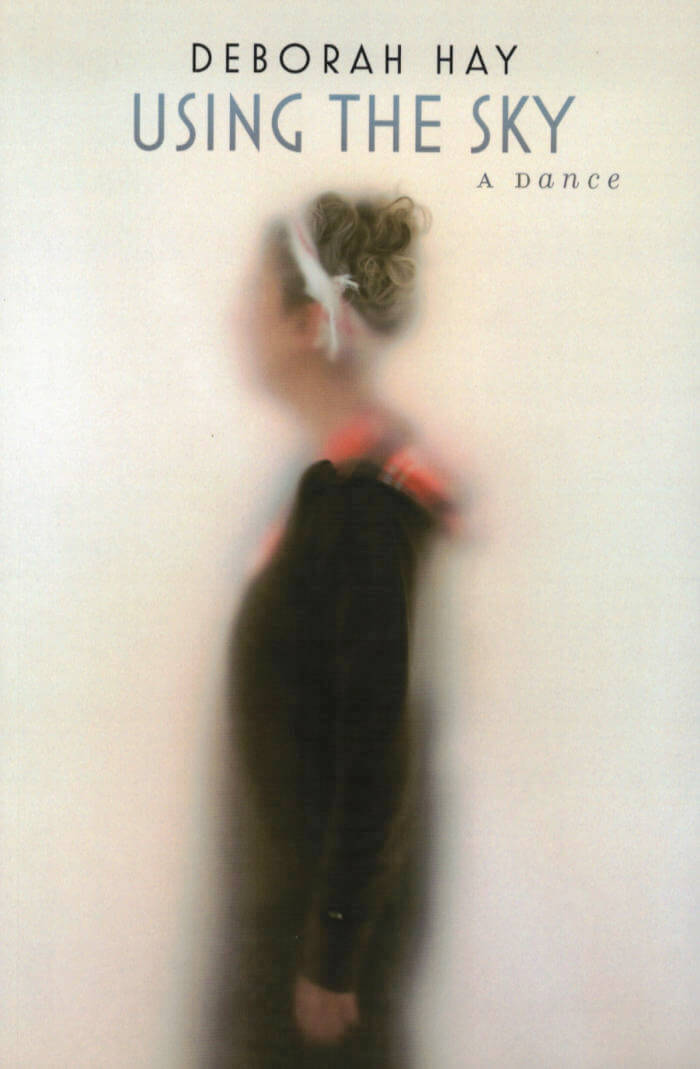
Using the Sky: A Dance
Using the Sky: A Dance explores Deborah Hay's choreographic imagery through a broad range of alternately intimate, descriptive, poetic, analytical and often playful engagement with language and writing.
Includes notes on four dances, If I Sing to You (2008), No Time to Fly (2010), A Lecture on the Performance of Beauty (2003), and the solo My Choreographed Body (2014)

Houses To Die In and Other Essays on Art
Art critical essays focusing on artworks that, in various ways, convey a sense of unheroic "trouble."
Stories of the undead of contemporary painting, the mediation of pain, photography courting stupidity, sculpture and architecture courting animism, populism in avant-garde art, fear of avant-garde territorialism, ambivalent networking, displaced abstractions and misplaced weather systems.
The essays assembled in this volume were all written over the past twenty years—a period in which Ina Blom pursued art critical writing alongside more academic work and when the boundaries between the two genres grew at times deliberately blurred. Dispersed as they were across a variety of publications with limited accessibility—out-of-print anthologies and artist's books, hard-to-find art catalogues, journals, and magazines protected by paywalls—Houses To Die In and Other Essays on Art at last brings them together, and not just for practical reasons. If the texts collected here have one thing in common, it is in a certain pull they display toward artistic projects that are not redemptive or exemplary, but which instead convey a sense of trouble: trouble actively sought by the artists or keenly felt by Blom. A distinctly unheroic trouble.
Born in Oslo in 1961, Ina Blom is an Associate Professor at the Department of Philosophy, Classics, History of Art and Ideas at the University of Oslo. She has written extensively on modern and contemporary art and is also active as an art critic.
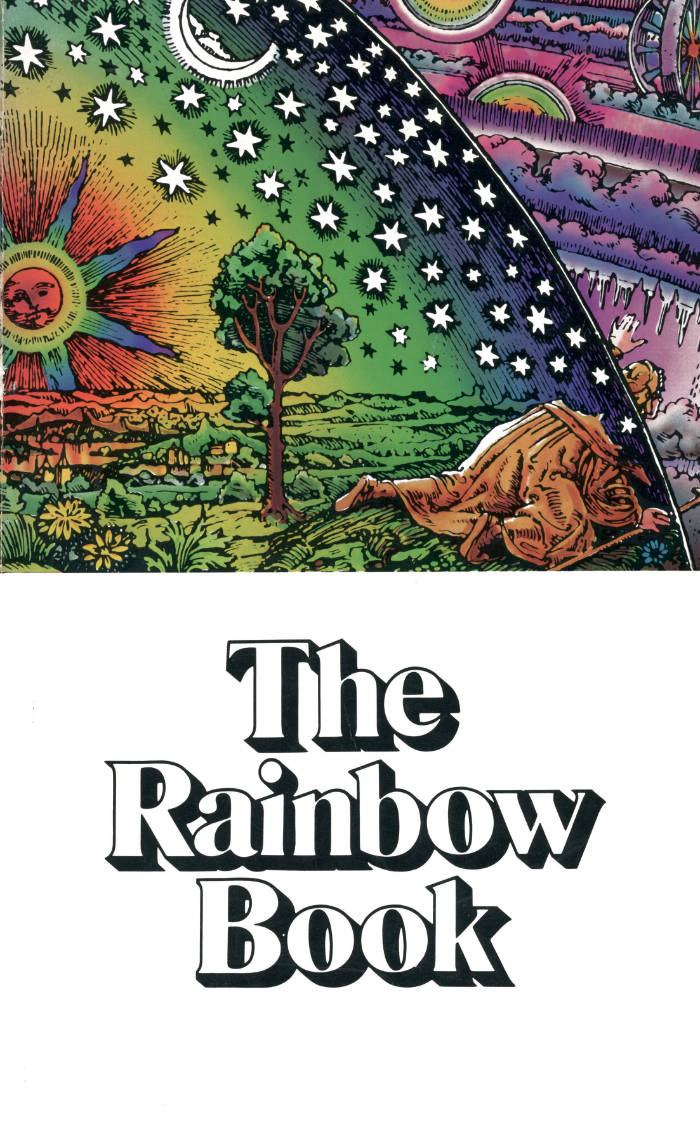
The Rainbow Book
F. Lanier Graham, Larry Wurn and 1 more
The book is a reprint of a cult text of post-1968 psychedelic culture: The Rainbow Book, published in 1975 in Berkeley, California, on the occasion of The Rainbow Show exhibition held at the Fine Arts Museums of San Francisco.
The Rainbow Book is a collection of essays and illustrations devoted to the rainbow and color spectra, analyzing the significance of color (both physical and metaphysical) from antiquity to modern times.
An encyclopedia of the cultural and artistic manifestations of the rainbow: in myth, magic and paintings, as well as in prints and poems. The book includes poems by Virgil, Dante, Blake, Keats, Wordsworth, and others; paintings by Giotto, Bosch, Van der Weyden, Dürer, Rubens, Blake, Turner, Constable, and Church; and the sacred art of Tibet.
The book is printed on sheets of different colors, according to the rainbow spectrum, and reports notions of increasing complexity, accessible at first to younger readers and later to the more experienced and interested in the subject.
The reprint accompanies the exhibition Rainbow. Colors and Wonders between Myths, Arts and Science at MUDEC in Milan (February 16–July 2, 2023), and the release of the first issue of MUdec United.

The Whisper
The Whisper is Félicia Atkinson's new artist's book, bringing together photographs, drawings and poems. They revolve around the eponymous installation located on the pointe d'Agon, on the west coast in Normandy. On a dune acquired by the artist for the Conservatoire du Littoral, stands a pierced wooden sculpture. Around this sculpture, inside this wild dune and facing the sea, the walker is invited to become a whisperer, and listen to what surrounds him.
What if whispering could be a metaphor for a way of creating and living within biodiversity? Observing and listening, being present to the world while only leaving gentle trace? The studio then becomes a garden, the exhibition space a dune, deep listening a method of working and exchanging with the public and the reader.
Experimental musician, sound and visual artist Félicia Atkinson (born 1981) lives on the wild coast of Normandy (France). She has played music since the early 2000s. She has released many records and a novel on Shelter Press, the label and publisher she co-runs with Bartolomé Sanson.
For Félicia Atkinson, human voices inhabit an ecology alongside and within many other things that don't speak, in the conventional sense: landscapes, images, books, memories, ideas. The French electro-acoustic composer and visual artist makes music that animates these other possible voices in conversation with her own, collaging field recording, MIDI instrumentation, and snippets of essayistic language in both French and English. Her own voice, always shifting to make space, might whisper from the corner or assume another character's tone. Atkinson uses composing as a way to process imaginative and creative life, frequently engaging with the work of visual artists, filmmakers, and novelists. Her layered compositions tell stories that alternately stretch and fold time and place, stories in which she is the narrator but not the protagonist.

LSD #03 – A DIY Issue
The third issue of Le Signe Design (the Cahiers of the National Graphic Design Center) is about DIY practices and is based on the work of Gilles de Brock, graphic designer who became a ceramic tile manufacturer.
Do It Yourself practices are not, as is commonly assumed, limited to home improvement, nor just a way of subverting—hacking—a given social and political organization. They are also a way of looking both forward and backward, at our future and our heritage. They involve our heritage insofar as they allow constituted groups to revive past knowledge and skills threatened with extinction. They look forward in that they make it possible to create tools that do not yet exist but could.
The applications of the Do It Yourself approach range from niche practices to everything everywhere, and what they have in common is that they are always in opposition to the mass market. Some examples of this extremely diversified movement include self-publishing, cosplay, biotechnology, hacking (especially in the sense of programming), and producing digital artworks and music. Its most mediatized (and often romanticized) contemporary manifestation is what are called fablabs, but this term is too limited to cover the phenomenon in all its vast variety.
The roots of the DIY movement go back to the magazines Popular Mechanics(1902) and Mechanix Illustrated (1928), popular education publications meant for readers in small towns and the countryside who needed to be self-reliant and repair broken manufactured items rather than buying new ones. The late 1960s saw the emergence of movements motivated by environmental concerns and a distrust of consumer society. Many people—like some student co-op members, hippies in North America and punks in Europe—wanted to share resources. Stewart Brand's famous Whole Earth Catalogue, subtitled "Access to tools", launched in 1968, constitutes our contemporary reference.
This issue is appearing in parallel with the solo exhibition retracing the career of Gilles de Brock, whose production is deeply infused with the DIY spirit. Yet his practice can't be reduced to the things he has actually made. It is part of the kind of knowledge-sharing economy proclaimed in Brand's counter-culture manifesto, able to go even further today thanks to the participatory and interactive Web 2.0.
Texts by Pao Lien Djie, Maya Ober, Nina Paim, Anthony Masure, Guillaume Helleu, Tereza Bettinardi, Jean-Michel Géridan.

Chroniques et poèmes sarcastiques à prendre au premier degré d'une gouine peut-être femme peut-être poète
How To Become est une maison d'édition autogérée basée à Paris. Nous publions les textes d'auteuces engagés dans des pratiques féministes et peu diffusés par le réseau des grandes maisons d'édition françaises.
Créée en 2016, elle est composée d'artistes et écrivaires en majorité gouines, HTB publie de la litterature expérimentale née d'influences post-post- sapphiques ainsi qu'un choix de tradu d'auteuices non traduites en langue française. HTB s'articule autour d'ateliers d'écriture: How to Become a Lesbian, et d'une revue annuelle publiant les choses issues de l'atelier.